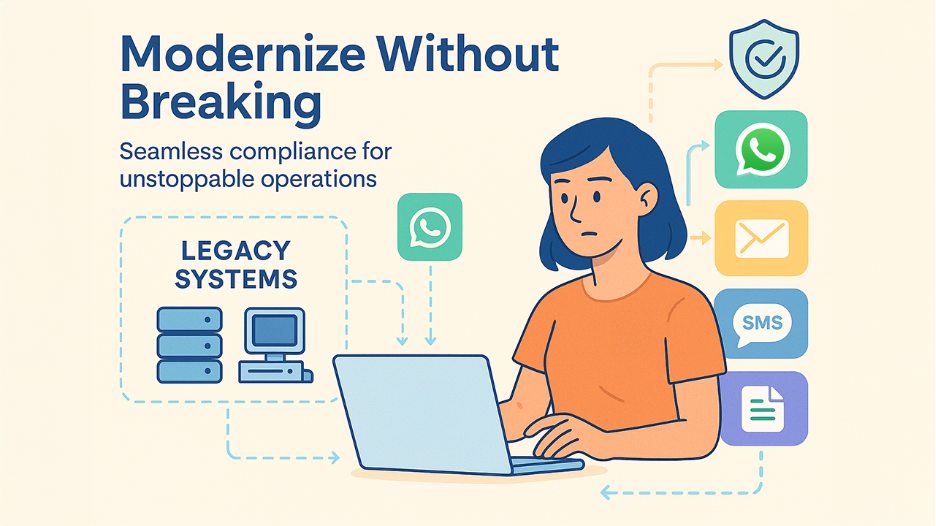Establishing IT infrastructure presents a constant challenge for organizations. Prior to the development of contemporary communication channels, the systems that manage their primary functions were constructed. When many legacy platforms
Establishing IT infrastructure presents a constant challenge for organizations. Prior to the development of contemporary communication channels, the systems that manage their primary functions were constructed. When many legacy platforms were created, email was the main digital communication tool. These days, workers use mobile devices, messaging apps, and collaboration platforms to create business records that don't fit into traditional archiving systems.
Regulations have not waited for technological advancements. Regardless of the platform, regulated industries like financial services, healthcare, and law must record, preserve, and generate business communications. The volume, variety, and velocity of contemporary messaging data are too much for legacy systems that were ideal for email and phone records.
The Gap in Compliance
Structured data was the foundation of traditional enterprise systems. Databases contain customer records. Emails were sent according to standard procedures. Logs from phone systems were predictable. Since the data in these systems was stored in well-known locations and followed standard formats, they could be audited.
These presumptions are disproved by contemporary business communication. Messages are sent on dozens of platforms. As participants move from email to chat to video calls, conversations take place across a variety of platforms. Workers use their own gadgets for work. In ways that legacy systems never foresaw, the line between personal and professional communication becomes increasingly hazy.
This poses a real risk to compliance. Companies that have outdated systems are not exempt from regulations such as SEC 17a-4, FINRA, GDPR, and HIPAA. Regardless of the platform used, organizations are required to provide communications upon request from regulators. Achieving GDPR compliance and similar organizations requires both technical infrastructure to archive messages and policy frameworks to manage data retention, access rights, and deletion requests across legacy and modern platforms. Penalties for not keeping necessary records make system upgrades appear cheap in contrast.
The Challenge of Retrofit

Core business system replacements are extremely expensive and disruptive. Critical operations that cannot withstand downtime are supported by numerous legacy platforms. Few people possess the knowledge and skills necessary to maintain older systems, as they are familiar with the peculiarities and workarounds that keep everything functioning.
Complete replacement isn't always practical or required. The difficulty lies in expanding these systems to record contemporary communication data without interfering with their core capabilities. Instead of starting from scratch, this calls for implementing compliance capabilities around the edges.
What must be recorded determines the technical strategy. Every communication channel that staff members use for work-related purposes must be listed by the organization. In addition to the well-known channels like chat and email, this also includes text messages, WhatsApp, direct messages on social media, and shared documents where business talks take place.
Establishing the Layer of Compliance
Rather than replacing legacy systems, effective retrofitting views message compliance as an independent layer that communicates with them. By converting contemporary message data into formats that legacy systems can handle and store, this compliance layer operates between communication platforms and existing archives.
Usually, the architecture consists of multiple parts. In order to record messages in real time, connectors integrate with every communication platform. These connectors need to present data in a consistent format while managing the platform's technical details. Data from various sources is normalized by a transformation layer, guaranteeing consistent metadata regardless of the source. Storage systems preserve links to metadata in legacy databases while archiving the actual message content.
For businesses with compliance requirements, having reliable tools to archive and retrieve text message records becomes crucial. Because messages are stored on devices rather than centralized servers, mobile messaging poses a unique challenge to traditional systems. Multi-device message capture, SMS and app-based messaging support, conversation context and attachment preservation, and archived data integration with current compliance workflows are all requirements for effective tools. In the exact area where regulators are paying more attention, organizations with inadequate archiving infrastructure end up with compliance gaps.
Resolving Typical Issues
Legacy systems were not able to manage the volume of data produced by contemporary messaging. A single, overburdened worker may generate thousands of messages across several platforms each month. This volume overwhelms storage systems designed to manage dozens of emails per day.
Search and retrieval present additional challenges. Legacy systems often use simple keyword searching. Modern compliance requires the ability to locate cross-platform conversations, reconstruct threads, and perform semantic search. Both new and old data sources must be accessible through search features in retrofitted systems.
Retention policies make things more complicated. Retention requirements may vary depending on the type of message. Generally, legacy systems use general retention guidelines. Granular control over what is kept, for how long, and under what circumstances it can be removed is necessary for modern compliance.
Disruption-Free Implementation
Retrofits that are successful occur gradually. Businesses begin by determining which areas pose the greatest risk to compliance and taking care of those first. Communications about financial trading may take precedence over those about customer service and internal operations.
Production systems and testing take place concurrently. While legacy systems carry on as usual, the new compliance layer records messages. Integration problems are exposed by this parallel operation before they have an impact on business operations. Organizations can gradually transition compliance functions to the new system once the retrofit shows itself to be dependable.
Training is just as important as technology. The new architecture must be understood by the IT staff. Tools are necessary for compliance teams to search for and retrieve messages. Clear guidelines regarding which platforms are acceptable for business communication are necessary for employees. If people do not use the best technical solution correctly, it will fail.
The Price of Passivity
The risk of postponing compliance upgrades increases with time. The backlog of unarchived messages grows every day. Modern communication platforms are receiving more regulatory attention. The severity of non-compliance penalties increases.
Competitors who have taken compliance into account, meanwhile, benefit from operational advantages. They are confident in their ability to use new communication tools. They react fast to requests from regulators. They stay away from the expense and distraction of noncompliance.
Although replacing legacy systems will eventually be necessary, retrofitting reduces compliance risk right away and buys time. Businesses that make the necessary investments in message compliance infrastructure safeguard themselves now while preparing for the demands of the future.
Respond to this article with emojis






